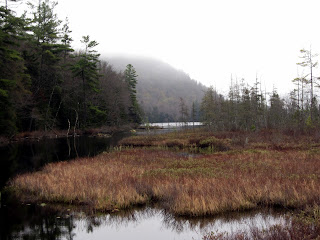 |
| Cloud moving in over Oxbow Outlet, Oil on canvasboard, 16X20 |
I stopped to see my pal
Jamie Grossman last week, and we fell into a conversation about sketchbooks. We both use them religiously, but (unlike Jamie) I tend to use the cheapest sketchbooks available and fill them with scribbled notes. Ever generous, Jamie gave me a
Stillman & Birn Alpha Series sketchbook and suggested I try using it with watercolors, gel pens, acrylics, or ink instead of simply drawing with a pencil or graphite stick.
 |
| Sketch #1, from the seat of my car. |
Jamie does lovely sketchbooks that hover on the line of being artist’s books—very lovely, very lively. I’m not interested in going there, but I can see the value in doing color sketches instead of pencil sketches. And all mental stretches are a good thing, right?
 |
Balanced sketchbook on top
of my pochade box. |
I like to sketch whenever I have to sit, so I brought it with me to church last Sunday. However, a dynamic young rapper named
CuevasWalker was preaching, and he defied capture in any form except the loosest gesture drawing.
I am in a self-imposed hermitage this week, which seems like the perfect opportunity to test Jamie’s idea. I brought only a #2 pencil and a Cotman pocket watercolor kit (with its one brush). My reasoning is that if my sketch kit expands beyond what I can put in my pocket, it’s useless.
 |
Sketch #2. I still can’t bring myself to
paint across the spread like Jamie does… |
Obstacle number one was apparent as soon as I reached my location: sketchbooks don’t fit on easels; they need to be balanced. My first sketch, therefore, was done from the driver’s seat of my trusty Prius—and I worked very fast because I was parked in a fire lane.
I tried again, balancing the sketchbook on top of my pochade box. That worked just fine, but I don’t think this sketch told me more about my composition than a pencil drawing would have.
 |
Bug repellent… a necessity in
the spring in the Adirondacks. |
Then I moved to oils. And that ended up being one of those transcendent experiences where one is totally engrossed in the process of painting, and whether it turns out well is immaterial (although, looking at these sketches, I do wish I’d worked from my original vantage point).
I will try this process again today. Marilyn Fairman joins me to paint for two days. I’m both excited to paint with her and sad to see the solitude end.
P.S. Sorry about my month’s absence. We were marrying off our eldest, and that was an amazing project in itself, one which left no time for other creative ventures.
 |
| The place itself… |











